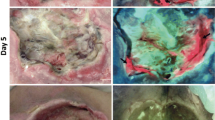Abstract
Purpose
Infection is ubiquitous and a major cause of morbidity and mortality. The most reliable method for localizing infection requires radiolabeling autologous white blood cells ex vivo. A compound that can be injected directly into a patient and can selectively image infectious foci will eliminate the drawbacks. The resolution of infection is associated with neutrophil apoptosis and necrosis presenting phosphatidylserine (PS) on the neutrophil outer leaflet. Targeting PS with intravenous administration of a PS-specific, near-infrared (NIR) fluorophore will permit localization of infectious foci by optical imaging.
Methods
Bacterial infection and sterile inflammation were induced in separate groups (n = 5) of mice. PS was targeted with a NIR fluorophore, PSVue®794 (2.7 pmol). Imaging was performed (ex = 730 nm, em = 830 nm) using Kodak Multispectral FX-Pro system. The contralateral normal thigh served as an individualized control. Confocal microscopy of normal and apoptotic neutrophils and bacteria confirmed PS specificity.
Results
Lesions, with a 10-s image acquisition, were unequivocally visible at 5 min post-injection. At 3 h post-injection, the lesion to background intensity ratios in the foci of infection (6.6 ± 0.2) were greater than those in inflammation (3.2 ± 0.5). Image fusions confirmed anatomical locations of the lesions. Confocal microscopy determined the fluorophore specificity for PS.
Conclusions
Targeting PS presented on the outer leaflet of apoptotic or necrotic neutrophils as well as gram-positive microorganism with PS-specific NIR fluorophore provides a sensitive means of imaging infection. Literature indicates that NIR fluorophores can be detected 7–14 cm deep in tissue. This observation together with the excellent results and the continued development of versatile imaging devices could make optical imaging a simple, specific, and rapid modality for imaging infection.








Similar content being viewed by others
References
Thakur ML, Coleman RE, Welch MJ (1977) Indium-111-labeled leukocytes for the localization of abscesses: preparation, analysis, tissue distribution and comparison with Ga-67 citrate in dogs. J Lab Clin Med 89:217–228
Desai AG, Thakur ML (1986) Radiolabeled blood cells: techniques and applications. Crit Rev Clin Lab Sci 24:95–122
Thakur ML, Marcus CS, Kipper SL et al (2001) Imaging infection with LeuTech. Nucl Med Commun 22(5):513–519
Kipper SL, Rypins EB, Evans DG et al (2000) Neutrophil-specific 99mTc-labeled anti-CD15 monoclonal antibody imaging for diagnosis of equivocal appendicitis. J Nucl Med 41(3):449–455
Thakur ML, Marcus CS, Henneman P et al (1996) Technetium-99 m labeled anti-SSEA-1 antibody specific for human neutrophils: In vivo evaluation and assessment as an agent for imaging infectious diseases. J Nucl Med 37:1789–1795
Rao PS, Pallela VR, Vassileva-Belnikolovska D et al (2000) A receptor-specific peptide for imaging infection and inflammation. Nucl Med Commun 21:1063–1070
Dockrell DH, Whyte MKB (2006) Regulation of phagocyte lifespan in the lung during bacterial infection. J Leukoc Biol 79:904–908
Simon HU (2003) Neutrophil apoptosis pathways and their modifications in inflammation. Immunol Rev 193:101–110
Fialkow L, Filho LF, Bozzetti MC et al (2006) Neutrophil apoptosis: a marker of disease severity in sepsis and sepsis-induced acute respiratory distress syndrome. Crit Care 10:R155
Bratton DL, Fadok VA, Richter DA et al (1997) Appearance of phosphatidylserine on apoptotic cells requires calcium-mediated nonspecific flip-flop and is enhanced by loss of the aminophospholipid translocase. J Biol Chem 272:26159–26165
Penn DL, Kim C, Zhang K et al (2010) Apoptotic abscess imaging with 99mTc-HYNIC-rhAnnexin-V. Nucl Med Bio 37:29–34
Hanshaw RG, Lakshmi C, Lambert TN et al (2005) Florescent detection of apoptotic cells by using zinc coordination complexes with a selective affinity for membrane surfaces enriched with phosphatidylserine. Chembiochem 6:2214–2220
Leevy WM, Gammon ST, Johnson JR et al (2008) Noninvasive optical imaging of staphylococcus aureus bacterial infection in living mice using a bis-dipicolylamine-zinc(II) affinity group conjugated to a near infrared fluorophore. Bioconjug Chem 19:686–692
Leevy WM, Lambert TN, Johnson JR et al (2008) Quantum dot probes for bacteria distinguish Escherichia coli mutants and permit in vivo imaging. Chem Commun (Camb) 20:2331–2333
Thakur ML, Lavender JP, Arnot RN et al (1977) Indium-111-labeled leukocytes in man. J Nucl Med 18:1014–1021
Leevy WM, Gammon ST, Jiang H et al (2006) Optical imaging of bacterial infection in living mice using a fluorescent near-infrared molecular probe. J Am Chem Soc 128(51):16476–16477
Vinegar R, Traux JF, Selph JL et al (1987) Pathway to carrageenan-induced inflammation in the hind limb of the rat. Fed Proc 46(1):118–126
Luker GD, Luker KE (2008) Optical imaging: current applications and future directions. J Nucl Med 49:1–4
Weissleder R, Ntziachristos V (2003) Shedding light onto live molecular targets. Nat Med 9:123–128
Acknowledgments
Dr. Mathew Thakur and Dr. Kaijun Zhang thank Dr. Donald Jungkind and Mr. David Lander for the supply of the microorganisms.
Research was supported by NIH/NCRR 1S10RR 026678–01 (MLT) and NIH 5P30 CA-56036.
Conflict of Interest
M.L. Thakur, K. Zhang, B. Paudyal, D. Devakumar, M.Y. Covarrubias, C. Cheng, and E. Wickstrom have no conflict of interest. Drs. Brian D. Gray and Koon Y. Pak are the employees of Molecular Targeting Technologies, Inc. which sells PSVue®794.
Author information
Authors and Affiliations
Corresponding author
Additional information
An erratum to this article can be found at http://dx.doi.org/10.1007/s11307-011-0498-y.
Rights and permissions
About this article
Cite this article
Thakur, M., Zhang, K., Paudyal, B. et al. Targeting Apoptosis for Optical Imaging of Infection. Mol Imaging Biol 14, 163–171 (2012). https://doi.org/10.1007/s11307-011-0490-6
Published:
Issue Date:
DOI: https://doi.org/10.1007/s11307-011-0490-6




